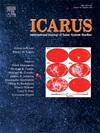了解水星多米尼奇陨石坑空洞的成分演化
IF 2.5
2区 物理与天体物理
Q2 ASTRONOMY & ASTROPHYSICS
引用次数: 0
摘要
水星上的空洞是由挥发性损失形成的小洼地,为了解行星表面和浅层地下的挥发性库存提供了重要线索。我们研究了多米尼奇陨石坑在不同阶段的脱挥发空洞的组成。通过将机器学习方法应用于信使水星双成像系统数据,我们定义了研究区域内的表面单元,并提取了它们的反射光谱。我们采用线性(面)光谱模型,利用实验室硫化物、氯化物、石墨和硅酸盐矿物光谱来估计空洞及其周围地形的组成。在多米尼奇,陨石坑边缘/墙壁上的空洞被解释为活跃的,而陨石坑中心的空洞被解释为逐渐减弱的空洞。研究发现,活性空洞主要由硅酸盐(辉长石和钠长石)组成,并含有微量的石墨和ca。相比之下,减弱空腔含有少量的硫化物(mg和ca)和石墨,但硅酸盐含量略低于活性空腔。洼地周围的低反射率地形的光谱似乎主要由石墨和硫化物组成,这使其看起来更暗。我们认为陨石坑的空洞是由于硫化物的热分解形成的,主要是mg可能与ca混合,也可能是石墨的耗尽。随着脱挥发作用的减弱,主要由硅酸盐矿物组成的混合物留在空心中,阻碍了进一步的垂直生长。本文章由计算机程序翻译,如有差异,请以英文原文为准。
Understanding compositional evolution of hollows at Dominici crater, Mercury
Hollows on Mercury are small depressions formed by volatile loss, providing important clues about the volatile inventory of the planet's surface and shallow subsurface. We investigate the composition of hollows in various phases of devolatilization at Dominici crater. By applying a machine learning approach to MESSENGER Mercury Dual Imaging System data, we defined surface units within the study area and extracted their reflectance spectra. We applied linear (areal) spectral modeling using laboratory sulfides, chlorides, graphite, and silicate mineral spectra to estimate the composition of hollows and their surrounding terrains. At Dominici, the hollow on the crater rim/wall is interpreted to be active, while that in the center of the crater is interpreted as a waning hollow. We find that the active hollow predominantly comprises silicates (augite and albite), with a trace amount of graphite and CaS. In contrast, waning hollows contain marginally elevated sulfides (MgS and CaS) and graphite, but slightly lower silicates than the active hollow. The spectra of low reflectance terrain surrounding the hollows appear to be dominated by graphite and sulfides, which contribute to its darker appearance. We suggest that hollow at the crater forms due to thermal decomposition of sulfides, primarily MgS possibly mixed with CaS, as well as possible the depletion of graphite. As devolatilization wanes, a mixture of predominantly silicate minerals remains in the hollows — impeding further vertical growth.
求助全文
通过发布文献求助,成功后即可免费获取论文全文。
去求助
来源期刊

Icarus
地学天文-天文与天体物理
CiteScore
6.30
自引率
18.80%
发文量
356
审稿时长
2-4 weeks
期刊介绍:
Icarus is devoted to the publication of original contributions in the field of Solar System studies. Manuscripts reporting the results of new research - observational, experimental, or theoretical - concerning the astronomy, geology, meteorology, physics, chemistry, biology, and other scientific aspects of our Solar System or extrasolar systems are welcome. The journal generally does not publish papers devoted exclusively to the Sun, the Earth, celestial mechanics, meteoritics, or astrophysics. Icarus does not publish papers that provide "improved" versions of Bode''s law, or other numerical relations, without a sound physical basis. Icarus does not publish meeting announcements or general notices. Reviews, historical papers, and manuscripts describing spacecraft instrumentation may be considered, but only with prior approval of the editor. An entire issue of the journal is occasionally devoted to a single subject, usually arising from a conference on the same topic. The language of publication is English. American or British usage is accepted, but not a mixture of these.
 求助内容:
求助内容: 应助结果提醒方式:
应助结果提醒方式:


